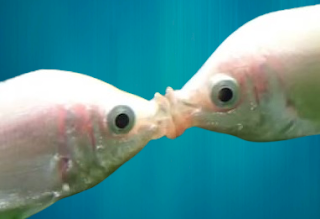This fish's name comes from the fact that it appears to be kissing, but experts aren't entirely sure about its exact purpose. It is thought to be a simple territorial-challenging action that occurs between two males. This hypothesis is reinforced by the fact that aging appears to reduce the desire to compete with one another. The need for mating territories also lessens with aging.
The kissing gourami, sometimes known as a kisser, is native to the Indonesian island of Java and can also be found in Borneo, Thailand, Malaysia, and Cambodia. This kind of fish is widely grown as a food fish in the southern Indochina region.
This fish comes in three color varieties: pinkish or flesh-colored; silver-green (commonly known as the "green kisser"); and mottled or piebald. The pink variety is less common in nature and is caused by a loss in pigmentation known as leucism. Due to the color preference of aquarium owners, this feature has been carefully developed for the aquarium trade.
Kissing gouramis have a history of fighting with certain kinds of fish and should not be housed with smaller fish. While they can be kept in a communal tank with medium-sized fish, owners should keep a constant eye on them to ensure they are not attacking other fish. Some species might be added to the tank, such as tetras, barbs, cichlids, and catfish.
Male vs Female Kissing Gourami Identification
The male and female kissing gourami are nearly identical in appearance, from their round shape to their thick fleshy lips. Before spawning, it is nearly impossible to confirm the sex of these fish. During the mating season, the female's body gets spherical as it fills with eggs.
Even though male and female specimens are oddly similar, physical size may provide an indication of gender. If you get a chance to observe a group of kissing gouramis, you'll note that the females are slightly larger and thicker-bodied than the males.

Kissing Gourami Breeding
Circling is the first step in spawning, followed by nudging and dancing. This is followed by a furious tail pounding. The male eventually curls his body around the female, flipping her upside down. Hundreds or possibly thousands of eggs are released by the female, which are fertilised by the male as they rise to the surface.
The eggs will stick to floating plants or lettuce if they are placed on the water's surface prior to spawning, and the fry will feed on the infusoria that develops on the plants. After spawning, remove the adult fish since they may consume their own offspring.
It takes about a day for eggs to hatch, after which the fry will be able to swim on their own. The best way to feed them is to give them very fine flake foods or small live foods like newly hatched brine shrimp.
Kissing Gourami Breeding Care
Kissers require warm water and a healthy diet of plant stuff. Artificial plants or strong real plants like Java fern or Java moss can be used as a habitat. The stems of living, tender plants are more likely to be eaten than those that have been wilted.
While kissers can reach a height of a foot or more in the wild, they normally maintain about half that size in captivity. This species should not be kept in mini-tanks since even a small kisser will grow too large for an aquarium of less than 30 gallons. It is not uncommon for these fish to live for more than a decade with adequate care.








0 Comments